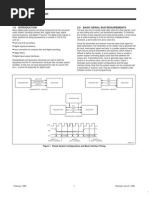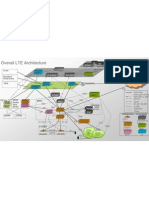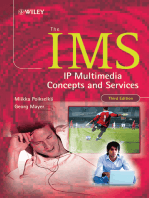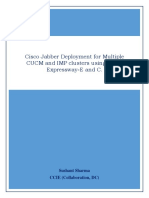SPI Interface Specification
Uploaded by
narender47SPI Interface Specification
Uploaded by
narender47Technical Note 15
SPI Interface Specification
OBJECTIVE
This document specifies the Serial Peripheral Interface (SPI) that is used in the 1-axis SCA61T and the 2-axis SCA100T inclinometers.
THE SPI INTERFACE
A Serial Peripheral Interface (SPI) system consists of one master device and one or more slave devices. The master is defined as a microcomputer providing the SPI clock, and the slave as any integrated circuit receiving the SPI clock from the master. The ASIC in VTI Technologies products always operates as a slave device in master-slave operation mode. The SPI has a 4-wire synchronous serial interface. Data communication is enabled with a low active Slave Select or Chip Select wire (CSB). Data is transmitted with a 3-wire interface consisting of wires for serial data input (MOSI), serial data output (MISO) and serial clock (SCK)..
MASTER MICROCONTROLLER
DATA OUT (MOSI) DATA IN (MISO) SERIAL CLOCK (SCK) SS0 SS1 SS2 SS3 SI SO SCK CS SI SO SCK CS SI SO SCK CS SLAVE SI SO SCK CS
Figure 1. Typical SPI connection The SPI interface in VTI products is designed to support almost any micro controller that uses software implemented SPI. However it is not designed to support any particular hardware implemented SPI found in many commercial micro controllers. The SPI interface is used for testing and calibration purposes, and it can also be used in the final application. Some of the test and calibration commands are disabled in normal use, and are not documented here. The data transfer uses the following 4-wire interface: MOSI MISO SCK CSB master out slave in master in slave out serial clock chip select (low active) P ASIC ASIC P P ASIC P ASIC
3 May 2004
VTI Technologies reserves all rights to modify this document prior notice.
Each transmission starts with a falling edge of CSB and ends with the rising edge. During the transmission, commands and data are controlled by SCK and CSB according to the following rules: commands and data are shifted; MSB first, LSB last each output data/status bits are shifted out on the falling edge of SCK (MISO line) each bit is sampled on the rising edge of SCK (MOSI line) after the device is selected with the falling edge of CSB, an 8-bit command is received. The command defines the operations to be performed the rising edge of CSB ends all data transfer and resets internal counter and command register if an invalid command is received, no data is shifted into the chip and the MISO remains in high impedance state until the falling edge of CSB. This reinitializes the serial communication. In order to perform other commands than those listed in Table 1, the lock register content must be set correctly. If such a command is fed without setting the correct lock register content, no data will be shifted into the chip and the MISO remains in high impedance state until the falling edge of CSB. data transfer to MOSI continues immediately after receiving the command in all cases where data is to be written to ASICs internal registers data transfer out from MISO starts with the falling edge of SCK immediately after the last bit of the SPI command is sampled in on the rising edge of SCK maximum data transfer speed exceeds 1 MHz clock rate
SPI command can be either an individual command or a combination of command and data. In the case of combined command and data, the input data follows uninterruptedly the SPI command and the output data is shifted out parallel with the input data.
C SB
0 1 2 3 4 5 6 7 8 9 10 11 12 13 14 15
SC K
C O M M AN D D A T A IN 7 6 5 4 3 2 1 0
M OSI
M ISO
H IG H IM PED AN C E 7 6 5
D A TA O U T 4 3 2 1 0
Figure 2. Command and data transmission over the SPI After power up, the circuit starts to operate in Measure mode. This is the normal operation mode that is used in the applications.
VTI Technologies Oy Myllynkivenkuja 6 P.O.Box 27 FIN-01621 Vantaa Finland Tel. +358 9 8791 81 Fax. +358 9 8791 8791 sales@vti.fi
VTI Technologies Oy Frankfurt Branch Rennbahnstr. 72-74 D-60528 Frankfurt am Main Germany Tel. +49 69 6786 880 Fax +49 69 6786 8829 sales.de@vti.fi
VTI Technologies, Inc. One Park Lane Blvd. Suite 804 - East Tower Dearborn, MI 48126 USA Tel. (313) 425 0850 Fax (313) 425 0860 sales@vtitechnologies.com
DIGITAL INTERFACE SPECIFICATION (TABLE 1)
Parameter Digital output load (1 SPI clock frequency Internal AD conversion Data transfer time Condition @ 500 kHz 150 38 Min Typ Max 1 500 Units nF kHz s s
@ 500 kHz
Note1. Minimum SPI frequency depends on the master microcontroller clock frequency
SPI COMMANDS
The SPI interface uses an 8-bit instruction (or command) register. The list of commands is given in Table 2.
Command MEAS RWTR STX STY RDAX RDAY Command format 00000000 00001000 00001110 00001111 00010000 00010001 Description: Measure mode (normal operation mode after power on) Read and write temperature data register Activate Self test for X-channel Activate Self test for Y-channel Read X-channel acceleration through SPI Read Y-channel acceleration through SPI
Table 2.
SPI commands. The commands in Italic are in use in the 2-axis SCA100T only.
Measure mode (MEAS) is standard operation mode after power-up. During normal operation, MEAS command is the exit command from Self test. Read temperature data register (RWTR) reads temperature data register during normal operation without effecting the operation. Temperature data register is loaded in every 150 s. The load operation is disabled whenever the CSB signal is low, hence CSB must stay high at least 150 s prior the RWTR command in order to guarantee correct data. The data transfer is presented in Figure 3, and the data is transferred MSB first. In normal operation, it does not matter what data is written into temperature data register during the RWTR command and hence writing all zeros is recommended. Self test for X-channel (STX) activates the self test function for the X-channel (Channel 1). Internal charge pump is activated and a high voltage is applied to the X-channel acceleration sensor element electrode. This causes electrostatic force that deflects the beam of the sensing element and simulates the acceleration to the positive direction. X-channel self-test is de-activated by giving the MEAS command. Self test for Y-channel (STY) activates the self test function for the Y-channel (Channel 2). Internal charge pump is activated and a high voltage is applied to the Y-channel acceleration sensor element electrode. This causes electrostatic force that deflects the beam of the sensing element and simulates the acceleration to the positive direction. Y-channel self-test is de-activated by giving the MEAS command. Note! This command is valid for the 2-axis SCA100T only. Read X-channel acceleration (RDAX) accesses the AD converted X-channel (Channel 1) acceleration signal stored in acceleration data register X. During normal operation, acceleration data register X is loaded in every 150 s. The load operation is disabled whenever the CSB signal is low, hence CSB must stay high at least 150 s prior the RDAX command in order to guarantee correct data. Data output is an 11-bit digital word that is fed out MSB first and LSB last. (see Figures 3 and 4).
VTI Technologies Oy Myllynkivenkuja 6 P.O.Box 27 FIN-01621 Vantaa Finland Tel. +358 9 8791 81 Fax. +358 9 8791 8791 sales@vti.fi
VTI Technologies Oy Frankfurt Branch Rennbahnstr. 72-74 D-60528 Frankfurt am Main Germany Tel. +49 69 6786 880 Fax +49 69 6786 8829 sales.de@vti.fi
VTI Technologies, Inc. One Park Lane Blvd. Suite 804 - East Tower Dearborn, MI 48126 USA Tel. (313) 425 0850 Fax (313) 425 0860 sales@vtitechnologies.com
Read Y-channel acceleration (RDAY) accesses the AD converted Y-channel (Channel 2) acceleration signal stored in acceleration data register Y. During normal operation acceleration data register Y is loaded in every 150 s. The load operation is disabled whenever the CSB signal is low, hence CSB must stay high at least 150 s prior the RDAY command in order to guarantee correct data. Data output is an 11-bit digital word that is fed out MSB first and LSB last. Note! This command is valid for the 2-axis SCA100T only.
RDAX COMMAND AND DATA TRANSMISSION OVER THE SPI (FIGURE 3)
0 0 MOSI data = 16 (in decimal format) 0 1 1 1 1 0 0 1 1 1 1
MS
MISO in high-impedance during 8-bit command.
MISO data = 975 (in decimal format)
LS
SPI BUS TIMING DIAGRAM (FIGURE 4)
T LS1 CSB SCK M OSI T VAL1 M ISO
M SB out
TCH
T CL
T LS2
T LH
T HOL
M SB in DATA in
T SET
LSB in
T VAL2
DATA out LSB out
T LZ
VTI Technologies Oy Myllynkivenkuja 6 P.O.Box 27 FIN-01621 Vantaa Finland Tel. +358 9 8791 81 Fax. +358 9 8791 8791 sales@vti.fi
VTI Technologies Oy Frankfurt Branch Rennbahnstr. 72-74 D-60528 Frankfurt am Main Germany Tel. +49 69 6786 880 Fax +49 69 6786 8829 sales.de@vti.fi
VTI Technologies, Inc. One Park Lane Blvd. Suite 804 - East Tower Dearborn, MI 48126 USA Tel. (313) 425 0850 Fax (313) 425 0860 sales@vtitechnologies.com
DC CHARACTERISTICS OF SPI INTERFACE (TABLE 3)
Parameter Input terminal CSB Pull up current Input high voltage Input low voltage Hysteresis Input capacitance Input terminal MOSI, SCK Pull down current Input high voltage Input low voltage Hysteresis Input capacitance Output terminal MISO Output high voltage Output low voltage Tristate leakage Conditions VIN = 0 V Symbol IPU VIH VIL VHYST CIN IPD VIH VIL VHYST CIN VOH VOL ILEAK Min 13 4 -0.3 Typ 22 Max 35 Vdd+0.3 1 Unit A V V V pF A V V V pF V V pA
0.23*Vdd 2 9 4 -0.3 17 29 Vdd+0.3 1
VIN = 5 V
0.23*Vdd 2 Vdd-0.5 5 0.5 100
I > -1mA I < 1 mA 0 < VMISO < Vdd
Supply voltage is 5 V unless otherwise noted. Current flowing into the circuit have positive values.
AC CHARACTERISTICS OF SPI INTERFACE (TABLE 4)
Parameter Terminal CSB, SCK (1 Time from CSB (10%) to SCK (90%) (1 Time from SCK (10%) to CSB (90%) Terminal SCK SCK low time SCK high time Terminal MOSI, SCK Time from changing MOSI (10%, (1 90%) to SCK (90%) . Data setup time Time from SCK (90%) to changing (1 MOSI (10%,90%) . Data hold time Terminal MISO, CSB Time from CSB (10%) to stable MISO (1 (10%, 90%) . Time from CSB (90%) to high (1 impedance state of MISO . Terminal MISO, SCK Time from SCK (10%) to stable MISO (1 (10%, 90%) . Terminal CSB Time between SPI cycles, CSB at high level (90%)
(1
Conditions
Symbol TLS1 TLS2
Min 120 120 1 1
Typ
Max
Unit ns ns s s
Load capacitance at MISO < 2 nF Load capacitance at MISO < 2 nF
TCL TCH
TSET THOL
30 30
ns ns
Load capacitance at MISO < 15 pF Load capacitance at MISO < 15 pF Load capacitance at MISO < 15 pF
TVAL1 TLZ
10 10
100 100
ns ns
TVAL2
100
ns
TLH
15
not production tested
VTI Technologies Oy Myllynkivenkuja 6 P.O.Box 27 FIN-01621 Vantaa Finland Tel. +358 9 8791 81 Fax. +358 9 8791 8791 sales@vti.fi
VTI Technologies Oy Frankfurt Branch Rennbahnstr. 72-74 D-60528 Frankfurt am Main Germany Tel. +49 69 6786 880 Fax +49 69 6786 8829 sales.de@vti.fi
VTI Technologies, Inc. One Park Lane Blvd. Suite 804 - East Tower Dearborn, MI 48126 USA Tel. (313) 425 0850 Fax (313) 425 0860 sales@vtitechnologies.com
You might also like
- Installing Domino Servers and Notes ClientsNo ratings yetInstalling Domino Servers and Notes Clients271 pages
- Power Systems-On-Chip: Practical Aspects of DesignFrom EverandPower Systems-On-Chip: Practical Aspects of DesignBruno AllardNo ratings yet
- Answers of Microprocessor (8085) & Electronics FAQ100% (23)Answers of Microprocessor (8085) & Electronics FAQ21 pages
- Signal Interfacing Using Can Bus: A Project ReportNo ratings yetSignal Interfacing Using Can Bus: A Project Report31 pages
- Netmanias.2013.09.11-LTE QoS - SDF and EPS Bearer QoS (En) PDFNo ratings yetNetmanias.2013.09.11-LTE QoS - SDF and EPS Bearer QoS (En) PDF16 pages
- I S Bus Specification: 1.0 2.0 Basic Serial Bus RequirementsNo ratings yetI S Bus Specification: 1.0 2.0 Basic Serial Bus Requirements7 pages
- Implementing Communication Bridge Between I2C and APBNo ratings yetImplementing Communication Bridge Between I2C and APB4 pages
- Design and Modeling of I2C Bus Controller PDFNo ratings yetDesign and Modeling of I2C Bus Controller PDF49 pages
- Deploying Lte Wireless Communications On Fpgas: A Complete Matlab and Simulink WorkflowNo ratings yetDeploying Lte Wireless Communications On Fpgas: A Complete Matlab and Simulink Workflow16 pages
- Design and Verification of Uart Using Verilog HDL: Kumari Amrita, Avantika KumariNo ratings yetDesign and Verification of Uart Using Verilog HDL: Kumari Amrita, Avantika Kumari5 pages
- The Internet of Things A Connected WorldNo ratings yetThe Internet of Things A Connected World9 pages
- Architecture of Fpga Altera Cyclone: BY:-Karnika Sharma Mtech (2 Year)100% (1)Architecture of Fpga Altera Cyclone: BY:-Karnika Sharma Mtech (2 Year)29 pages
- Computer Networks A Tanenbaum 5th EditionNo ratings yetComputer Networks A Tanenbaum 5th Edition39 pages
- Digital Signal Processor Evolution Over The Last 30 Years PDF100% (1)Digital Signal Processor Evolution Over The Last 30 Years PDF79 pages
- UVM Based Verification of CAN Protocol Controller Using System VerilogNo ratings yetUVM Based Verification of CAN Protocol Controller Using System Verilog5 pages
- Wireless Sensor Network Simulators A Survey and Comparisons: Harsh SundaniNo ratings yetWireless Sensor Network Simulators A Survey and Comparisons: Harsh Sundani17 pages
- Chapter 1: Introduction (PART 1) : Computer Networking: A Top Down Approach 6th Edition Jim Kurose, Keith RossNo ratings yetChapter 1: Introduction (PART 1) : Computer Networking: A Top Down Approach 6th Edition Jim Kurose, Keith Ross15 pages
- AXI4-Stream Upsizing Downsizing Data Width Converters For Hardware-In-The-Loop SimulationsNo ratings yetAXI4-Stream Upsizing Downsizing Data Width Converters For Hardware-In-The-Loop Simulations3 pages
- USB/IP: A Transparent Device Sharing Technology Over IP NetworkNo ratings yetUSB/IP: A Transparent Device Sharing Technology Over IP Network12 pages
- 100 TOP MICROPROCESSORS Questions and Answers PDF Microprocessors QuestionsNo ratings yet100 TOP MICROPROCESSORS Questions and Answers PDF Microprocessors Questions14 pages
- Connectivity Prediction in Mobile Ad Hoc Networks for Real-Time ControlFrom EverandConnectivity Prediction in Mobile Ad Hoc Networks for Real-Time Control5/5 (1)
- Radio Network Planning and Optimisation for UMTSFrom EverandRadio Network Planning and Optimisation for UMTSJaana Laiho4.5/5 (2)
- Emerging Technologies in Information and Communications TechnologyFrom EverandEmerging Technologies in Information and Communications TechnologyNo ratings yet
- VoLTE and ViLTE: Voice and Conversational Video Services over the 4G Mobile NetworkFrom EverandVoLTE and ViLTE: Voice and Conversational Video Services over the 4G Mobile NetworkNo ratings yet
- 3.6.1.1 Class Actvity - VPN Planning Design100% (1)3.6.1.1 Class Actvity - VPN Planning Design2 pages
- DR Shahedur Rahman: Computer Networks, Wireless and Mobile CommunicationsNo ratings yetDR Shahedur Rahman: Computer Networks, Wireless and Mobile Communications36 pages
- Application of Blockchain in Digital HealthcareNo ratings yetApplication of Blockchain in Digital Healthcare5 pages
- I'm A Hacker, But I'm The Good Kind of Hackers. and I've Never Been A Criminal. - Mikko Hypponen 01700764020No ratings yetI'm A Hacker, But I'm The Good Kind of Hackers. and I've Never Been A Criminal. - Mikko Hypponen 017007640202 pages
- How Does AXIS M5054 PTZ Network Camera WorkNo ratings yetHow Does AXIS M5054 PTZ Network Camera Work4 pages
- Zxr10 ZSR V2: Configuration Guide (Qos)No ratings yetZxr10 ZSR V2: Configuration Guide (Qos)68 pages
- F1102 GPRS Intelligent Modem Technical SpecificationNo ratings yetF1102 GPRS Intelligent Modem Technical Specification3 pages
- Power Systems-On-Chip: Practical Aspects of DesignFrom EverandPower Systems-On-Chip: Practical Aspects of Design
- Answers of Microprocessor (8085) & Electronics FAQAnswers of Microprocessor (8085) & Electronics FAQ
- Signal Interfacing Using Can Bus: A Project ReportSignal Interfacing Using Can Bus: A Project Report
- Netmanias.2013.09.11-LTE QoS - SDF and EPS Bearer QoS (En) PDFNetmanias.2013.09.11-LTE QoS - SDF and EPS Bearer QoS (En) PDF
- I S Bus Specification: 1.0 2.0 Basic Serial Bus RequirementsI S Bus Specification: 1.0 2.0 Basic Serial Bus Requirements
- Implementing Communication Bridge Between I2C and APBImplementing Communication Bridge Between I2C and APB
- Deploying Lte Wireless Communications On Fpgas: A Complete Matlab and Simulink WorkflowDeploying Lte Wireless Communications On Fpgas: A Complete Matlab and Simulink Workflow
- Design and Verification of Uart Using Verilog HDL: Kumari Amrita, Avantika KumariDesign and Verification of Uart Using Verilog HDL: Kumari Amrita, Avantika Kumari
- Architecture of Fpga Altera Cyclone: BY:-Karnika Sharma Mtech (2 Year)Architecture of Fpga Altera Cyclone: BY:-Karnika Sharma Mtech (2 Year)
- Digital Signal Processor Evolution Over The Last 30 Years PDFDigital Signal Processor Evolution Over The Last 30 Years PDF
- UVM Based Verification of CAN Protocol Controller Using System VerilogUVM Based Verification of CAN Protocol Controller Using System Verilog
- Wireless Sensor Network Simulators A Survey and Comparisons: Harsh SundaniWireless Sensor Network Simulators A Survey and Comparisons: Harsh Sundani
- Chapter 1: Introduction (PART 1) : Computer Networking: A Top Down Approach 6th Edition Jim Kurose, Keith RossChapter 1: Introduction (PART 1) : Computer Networking: A Top Down Approach 6th Edition Jim Kurose, Keith Ross
- AXI4-Stream Upsizing Downsizing Data Width Converters For Hardware-In-The-Loop SimulationsAXI4-Stream Upsizing Downsizing Data Width Converters For Hardware-In-The-Loop Simulations
- USB/IP: A Transparent Device Sharing Technology Over IP NetworkUSB/IP: A Transparent Device Sharing Technology Over IP Network
- 100 TOP MICROPROCESSORS Questions and Answers PDF Microprocessors Questions100 TOP MICROPROCESSORS Questions and Answers PDF Microprocessors Questions
- The IMS: IP Multimedia Concepts and ServicesFrom EverandThe IMS: IP Multimedia Concepts and Services
- LTE and LTE Advanced: 4G Network Radio InterfaceFrom EverandLTE and LTE Advanced: 4G Network Radio Interface
- CAMEL: Intelligent Networks for the GSM, GPRS and UMTS NetworkFrom EverandCAMEL: Intelligent Networks for the GSM, GPRS and UMTS Network
- Connectivity Prediction in Mobile Ad Hoc Networks for Real-Time ControlFrom EverandConnectivity Prediction in Mobile Ad Hoc Networks for Real-Time Control
- IP Multimedia Subsystem IMS A Complete GuideFrom EverandIP Multimedia Subsystem IMS A Complete Guide
- Radio Network Planning and Optimisation for UMTSFrom EverandRadio Network Planning and Optimisation for UMTS
- Emerging Technologies in Information and Communications TechnologyFrom EverandEmerging Technologies in Information and Communications Technology
- VoLTE and ViLTE: Voice and Conversational Video Services over the 4G Mobile NetworkFrom EverandVoLTE and ViLTE: Voice and Conversational Video Services over the 4G Mobile Network
- DR Shahedur Rahman: Computer Networks, Wireless and Mobile CommunicationsDR Shahedur Rahman: Computer Networks, Wireless and Mobile Communications
- I'm A Hacker, But I'm The Good Kind of Hackers. and I've Never Been A Criminal. - Mikko Hypponen 01700764020I'm A Hacker, But I'm The Good Kind of Hackers. and I've Never Been A Criminal. - Mikko Hypponen 01700764020
- F1102 GPRS Intelligent Modem Technical SpecificationF1102 GPRS Intelligent Modem Technical Specification

























































































